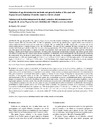Please use this identifier to cite or link to this item:
http://hdl.handle.net/10553/6249
| Title: | Validation of age determination methods and growth studies of the sand sole Pegusa lascaris (Soleidae) from the eastern-central Atlantic | Other Titles: | Validación de la determinación de la edad y estudios del crecimiento del lenguado de arena Pegusa lascaris(Soleidae) del Atlántico centro-oriental | Authors: | Pajuelo, J. G. Lorenzo, J. M. |
UNESCO Clasification: | 2401 Biología animal (zoología) | Keywords: | Pegusa lascaris Age determination Otoliths Growth models Determinación de la edad, et al |
Issue Date: | 2011 | Journal: | Ciencias Marinas | Abstract: | The age and growth of the sand sole Pegusa lascaris from the Canarian Archipelago were studied from 2107 fish collected\nbetween January 2005 and December 2007. To find an appropriate method for age determination, sagittal otoliths were observed by\nsurface-reading and frontal section and the results were compared. The two methods did not differ significantly in estimated age but the\nsurface-reading method is superior in terms of cost and time efficiency. The sand sole has a moderate life span, with ages up to 10 years\nrecorded. Individuals grow quickly in their first two years, attaining approximately 48% of their maximum standard length; after the second\nyear, their growth rate drops rapidly as energy is diverted to reproduction. Males and females show dimorphism in growth, with females\nreaching a slightly greater length and age than males. Von Bertalanffy, seasonalized von Bertalanfy, Gompertz, and Schnute growth models\nwere fitted to length-at-age data. Akaike weights for the seasonalized von Bertalanffy growth model indicated that the probability of choosing\nthe correct model from the group of models used was >0.999 for males and females. The seasonalized von Bertalanffy growth parameters\nestimated were: L? = 309 mm standard length, k = 0.166 yr?1, t0 = ?1.88 yr, C = 0.347, and ts = 0.578 for males; and L? = 318 mm standard\nlength, k = 0.164 yr?1, t0 = ?1.653 yr, C = 0.820, and ts = 0.691 for females. Fish standard length and otolith radius are closely correlated\n(R2 = 0.902). The relation between standard length and otolith radius is described by a power function (a = 85.11, v = 0.906) Se estudió la edad y el crecimiento del lenguado de arena Pegusa lascaris de las Islas Canarias a partir de 2107 ejemplares\ncapturados entre enero de 2005 y diciembre de 2007. Para determinar el método de estimación de la edad, se hicieron lecturas de los otolitos\nsagita enteros y de la sección frontal y se compararon los dos métodos. Ambos métodos no variaron significativamente en la estimación de la\nedad, pero el método de la lectura del otolito entero es superior en términos de costo y tiempo. El lenguado de arena presenta un ciclo de vida\nmoderado; se han registrado edades de 10 años. Los individuos crecen rápidamente durante los primeros dos años, cuando alcanzan\naproximadamente el 48% de su longitud; después del segundo año, su crecimiento se ralentiza considerablemente debido a que invierten su\nenergía en la reproducción. Se observó dimorfismo en el crecimiento entre machos y hembras: las hembras presentaron longitudes y edades\nligeramente superiores a las de los machos. Para describir el crecimiento, los modelos de von Bertalanffy (simple y estacional), el de Gompertz\ny el de Schnute se ajustaron a los datos de talla y edad. Los pesos de Akaike para el modelo estacional de von Bertalanffy indicaron que la\nprobabilidad de elegir el modelo correcto fue >0.999 para machos y hembras. Los parámetros estimados de la ecuación de crecimiento\nestacional de von Bertalanffy fueron los siguientes: L? = 309 mm longitud estándar, k = 0.166 año?1, t0 = ?1.880 año, C = 0.347 y ts = 0.578\npara los machos; y L? = 318 mm longitud estándar, k = 0.164 año?1, t0 = ?1.653 año, C = 0.820 y ts = 0.691 para las hembras. Se observó una\nalta correlación entre la longitud estándar y el radio de los otolitos (R2 = 0.902), que fue descrita mediante una función potencial (a = 85.11,\nv = 0.906). |
URI: | http://hdl.handle.net/10553/6249 | ISSN: | 0185-3880 | DOI: | 10.7773/cm.v37i3.1826 | Source: | Ciencias Marinas [ISSN 0185-3880], v. 37, p. 323-338 | Rights: | by-nc-nd |
| Appears in Collections: | Artículos |
SCOPUSTM
Citations
2
checked on Apr 21, 2024
WEB OF SCIENCETM
Citations
3
checked on Feb 25, 2024
Page view(s)
88
checked on Feb 17, 2024
Download(s)
177
checked on Feb 17, 2024
Google ScholarTM
Check
Altmetric
Share
Export metadata
Items in accedaCRIS are protected by copyright, with all rights reserved, unless otherwise indicated.
